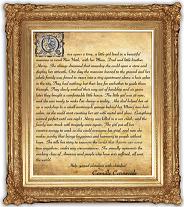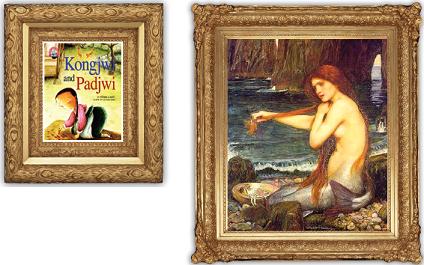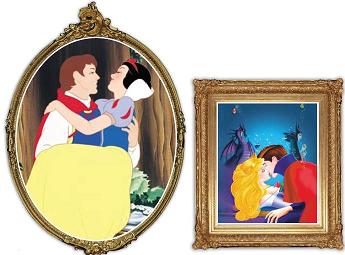Almost all fairy tales end with “Finally they live happily ever after.” Bad stepmother, pretty but pitiful princess, and happy ending are typical elements in the old stories. Unlike these tales you heard in your childhood, cruel and unimaginable things exist clearly in the original stories. Have you ever thought fairy tales are really beautiful and lovely tales? In course of that, can you find your own fairy tale interpreted by you?

Brutality behind the Beauty
“Once upon a time, there lived one person.” The thing which is started from this sentence and ends with a happy ending is a fairy tale. The ones that have come down until now are all happy ending stories regardless of whether they are the world masterpiece tales or traditional fairy tales in Korea. In it, a main character usually suffers misfortune but also has happiness in the end. Therefore its ending is as happy and gorgeous as can be when people see it standing in the fairy tales’ main person’s side. However it came out into the open recently that almost all of the children’s stories we heard and read in our childhood were not original things, but the things which were adapted for Walt Disney’s animations for children.1 In the original stories, there are too many cruel scenes including horrible punishment for villains to have doubts about that main character’s happy ending can be real happy. If so, do you know about the fact that the Snow White had her stepmother to wear iron shoes which were heated by fire and to dance wearing those shoes until she died?

The Snow White most people know is a dramatization by Walt Disney Company which deleted terrible substances in the original thing. Different from what we have known up to now, in the Grimm brothers’ original, greatly cruel scenes appear. The queen orders hunters to bring Snow White’s tongue and heart, and eat up in a flash when they give them for her. Of course, they are
not really Snow White’s tongue and heart but a pig’s. Because of this horrible action of the queen, Snow White imposes a severe punishment of having queen wear iron shoes heated by fire and do a dancing until she die. In addition, the Little Mermaid is not even a happy ending. She cut her tongue instead of drinking the water making her voice disappear in the original. Finally she fades away into the sea without achieving her unanswered love. In Cinderella, her stepsisters cut their heels to fit the glass shoes and their eyes are pecked by a pigeon in Cinderella’s wedding.2 Brutality can also be found in Korean traditional fairy tales. In Kongji and Patji, Kongji’s vindictive spirit, slain by Patji, visits a county magistrate. The magistrate makes Patji to be a salted fish, and sends it to Patji’s mother. These awful things exist clearly in the originals, but they can’t be found in the stories people heard in their childhood. In the majority of cases to the focus is changed to the happy ending like the wedding with a prince or the solving of all bad things. Children can feel happy when the main characters have a final victory, so the rest of it like cruel things which can be an obstruction for their happiness are deleted. Therefore children are easy to feel only blissful without having any question to brutality which exists in the original.
Beautiful Ending, Can It Be a Real Beauty?
With the thinking about the hidden cruelty in the course of the happy ending, can it be possible to consider about ‘beautiful ending is also real beauty?’ If it is told that terrible things were erased for protecting children’s dreams and hopes, there is also a secret in this aspect. In almost all of the fairy tales’ adaptations, Disney has had a great effect on them. The company’s efforts offered Americans dreams and fantasies as they suffered under the threat of the World War. To give hope for those in a state of panic, a Snow White who overcame the difficulties of stepmother and gained happiness came into the world. In original, the Snow White was expelled by her birth mother because of incest with her father, not by her stepmother. In the period of Europe this story was made, incest was not a surprising thing, and fables about it were prevalent at that time. The incest in a children’s story was not to the liking of the Grimm brothers’ values in the early 1800s and they removed that part of the story. In addition, only the things which can show Snow White’s purity, like clean white skin, and her beauty were emphasized. Another example, Sleeping Beauty didn’t wake up by a prince’s kiss when it was published first in Italy. She got pregnant by prince without knowing about that during her sleep, and the prince walked away without leaving any message for her. She woke up after 9 months later, only then did she know she was pregnant with twins.
At that time, when the originals were written, adults let children hear stories about incest and premarital pregnancy, things which have become taboo. Children were on an equal footing with adults because of their teens’ marriage.3 Different from the social atmosphere of those days, today’s almost all adults provide filtered stories to children. It reflects today’s mores that bans incest and premarital pregnancy. Moreover, children are not considered as adults these days, so people think that fairy tales need story filtering. In the course of it, tales are decorated not by genuine content only for children, but by things adults want to let children know. That is, many tales reflect grownup’s desires for children to see what adults want rather than helping children think about it themselves.4 For that, the elements existing in the originals disappeared from the today’s fairy tales when they were thought not beautiful to for adults.
Fairy Tales’ Other Faces


In addition, there are tales which move with the times such that fairy tales are not only for children anymore. These stories show that seniors are not just people making fairy tales for children, but people who also need tales. A domestic book Cruel Fairy Tales for Adults makes adults think differently on the tales and satirizes the fact that the world masterpieces were just products of grown-ups. Author Goethe said, “I learned a life rule by my mother’s stories of every night, not by university school days.” The tales’ influence doesn’t die down after the children grow up, so these efforts to make stories for adults can start. It cares not for only child’s healthy world of spirit, but serves as an accelerator to recall seniors’ memories repressed under the tired life. Thanks to that, tales have been used in several parts of society. A representative example of it is a treatment method analyzing the tales’ content for grownup’s talking and finding a cause of the disease. In the recent times, the stories are things not only for children and also have not only one conclusion. In society, efforts for reviving the original and for making the tales suitable for reality coexist. The fairy tales don’t insist only one story any longer. It has various faces reconstituted adequately for various people and the atmosphere of society.
“So... the princess lives with her prince on the white horse until the end, honey.” If the stories parents tell in their child’s bedside were described as its original, they can’t be told before children going to sleep. About the past’s tales which carried cruelty and criticized things in the society, Jung Eo-owl, a culture critic said, “Fairy tales were not for children who need protection and enlightenment, but for adults just having a smaller physique than adult. And isn’t it vaccination for giving study in advance about the society’s inclemency, human grief, and life’s cruelty before
1) Heo Hyun-ja「, Children never see the Grimm brothers’ tale」, ohmynews, 2005.11.26
2) Stephen Denning『, Success by storytelling』, elyoolibrary , 2006.09.10, p.98
3) Richard Jacks『, Topics in the world history』, Garam, 2001.09.24, p.160
4) Interpretation and Judgment the writing staff『, Literature and culture, Meets digital』, Sanjini, 2008.05.28, p.281
5) Kang Sun-ae「, Fairy tale’s inverse idea ‘Cinderella’s Sister,’ It can success as adult’s tale?」, Mydaily, 2010.03.24
6) Jung Eo-owl「, Adult’s tales get stained, by complex」, Shin Dong- A Ilbo, 2010.02.01


